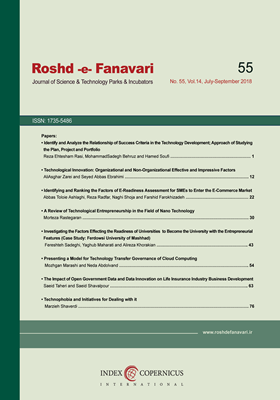Identifying and Ranking the Factors of E-Readiness Assessment for SMEs to Enter the E-Commerce Market
Subject Areas : Development of business models in small and medium enterprises
Abbas Toloie Eshlaghy
1
![]() ,
Farshid Farokhizadeh
2
*
,
Farshid Farokhizadeh
2
*
![]() ,
Reza Radfar
3
,
Naghi Shoja
4
,
Reza Radfar
3
,
Naghi Shoja
4
1 -
2 - Department of Maintenance Engineering, Faculty of Defense Science and Engineering, Imam Hussein Officers and Guard Training University, Tehran, Iran.
3 -
4 -
Abstract :
During the last decade, the key role of information and communication technology has proven to facilitate the process of transition and change of organizations; The e-readiness is the platform for entering into the modern time and activities in the networked world ad well as competition in the market. Thus, the design of e-readiness evaluation models, regarding the internal and environmental conditions of organizations and communities with the purpose of assessing their e-readiness level is necessary. However, without the evaluation of e-readiness of the organization, activity in the networked world will be impossible and have very high obstacles. In this paper, a brief introduction of the proposed models for the evaluation of the e-readiness and their classification have been discussed. Moreover, the factors influencing the e-readiness of the small and medium-sized enterprises to enter the e-commerce market have been investigated and detected through a combination approach of Shannon entropy. In this paper, after identifying and introducting existing models; the concepts, dimensions, and indices of the research were extracted and ranked by the Shannon entropy method. The results of this study show that the first ranked factors were organizational factors. Then environmental and man power factors were ranked second and third, respectively.
1- ادراکي، محمدرضا. بانک توسعه بنگاههاي کوچک و متوسط ايران، رشد فناوري. سال سوم، شماره 12، صفحات 33-26، پاییز 1386.
2- صلواتي سرچشمه، مداح، يزدانيراد. چارچوب سياستگذاري و برنامهریزی براي حمايت از ايجاد و توسعه بنگاههاي کوچک و متوسط، رشد فناوري. سال سوم، شماره 12، صفحات 49-39، پاییز 1386.
3- قاسمي، علمي مقدم. افزايش رقابتپذيري بنگاههاي کوچک و متوسط و تأمین مالي آنها با تأکید بر توسعه رويکرد خوشهاي، مجله اقتصادی- ماهنامه بررسي مسائل و سياستهاي اقتصادي. سال نهم، شمارههاي 94 و 93، صفحات 90-71، مرداد و شهریور 1388.
4- درّی نوکورانی، کسایی، فرخیزاده. بررسی و تحلیل تأثیر مدیریت دانش و نوآوری فرایند بر توسعه محصول جدید (مورد مطالعاتی- شرکتهای کوچک و متوسط شهرک صنعتی شمسآباد تهران)، مدیریت اطلاعات و دانششناسی، سال دوم، شماره 3، صفحات 22-11، زمستان 1394.
5- آذر، عادل. بسط و توسعه روش آنتروپی شانون برای پردازش دادهها در تولید محتوی، فصلنامه علمی- پژوهشی علوم انسانی دانشگاه الزهرا (س). سال یازدهم، شمارههای 37و38، صفحات 18-1، بهار و تابستان 1380.
6- سجادی امیری، ثریای، سجادی امیری. امکانسنجی راهاندازی تجارت الکترونیک در بنگاههای صادراتی استان مازندران با تکنیک AHP فازی، پژوهشگر مدیریت. سال نهم، شماره 26، صفحات 56-43، تابستان 1391.
7- نعیمی، پزشکیراد، چیذری، حسینی. چالشهای توسعه تجارت الکترونیک در بخش کشاورزی از دیدگاه کارشناسان ستادی وزارت جهاد کشاورزی، پژوهشهای ترویج و آموزش کشاورزی. سال چهارم، شماره 4، پیاپی 16، صفحات 41-29، زمستان 1390.
8- یمانی، نیکو، نجیمی، آرش، سلیمانی، بهاره. نیاز سنجی توسعه آموزش مجازی: ارزیابی میزان آمادگی در دانشکدههای دانشگاه علوم پزشکی اصفهان. مجله آموزش در علوم پزشکی. جلد ۱۷ ـ ویژهنامه بستههای تحول و نوآوری در آموزش علوم پزشکی صفحات ۷۰-۷۶، بهار 1396.
9- Barratt, Mark, Karsten, Rosdahl, “Exploring Business-To-Business Market sites”. European Journal of Purchasing & Supply Management, Vol 8, PP. 111-122, 2002.
10- Hartmans, J. Sifonis, J., “Net ready: Strategies for success in the E-economy”. McGraw hill, 2000.
11- Zoltan Alper, F., “Matchmaking Framewerk for B2B E- Marketplaces”. Informatica Economica, Vol. 14, No. 4, pp 164-170, 2010.
12- Kendall Jon, “Receptivity of Singapore's SMEs to electronic commerce adoption”. Journal of strategic Information System, 10, pp.223-242, 2001.
13- Bui, T. X. et al., “E-Commerce Readiness in East Asian APEC Economies – A Precursor to Determine HRD Requirements and Capacity Building”. Asian APEC Economies.
14- Vasant Desai, “Problems and Prospects of Small-Scale Industrial in India”. Himalaya Publishing House, No.12, pp. 225-237, 2003.
15- Ghobadian, A., D.Gallear, “TQM and Organisation size”. International Journal of Operations & Production Management, 17(2): 121-163, 1997.
16- Elizabeth Dorothy Eshun, “Internet and e-commerce adoption among SME Non-traditional exports”. Lulea university of technology, 2009.
17- Beck, C., “Mothering multiples: A meta synthesis of the qualitative research.MCN”. The American journal of maternal/Child Nursing,28. (2) pp93-99, 2002.
18- Alaaraj H. & Wati Ibrahim F. “An Overview and Classification of E-Readiness Assessment Models”. International Journal of Scientific and Research Publications, Volume 4, Issue 12, pp 1-5, 2014.
19- Barros, j and Sandelowski, M., “Handbook for Synthesizing Qualitative Research”. Springer publishing company Inc, 2007.
20- Ling, C.y., “Model of Factor Influences on Electronic Commerce Adoption Diffusion in Small & Medium Sized Enterprises”. Curtin University of technology, working paper, 2001.
21- Noblit, G.W, Hare, R.D., “Meta-Ethnography: Synthesizing qualitative studies”. Newbury park, CA: Stage, 1998.
22- Nazaj, D., Gorica, K., & Kordha, E., “The impact of e-readiness in the development of knowledge society; a case study of Albania”, Review of Applied Socio-Economic Research, vol. 8, issue 2, pp 116-123, 2014.
23- Rizk, N., “E-Readiness Assessment of Small and Medium Enterprises in Egypt: A Micro Study”. Topics in Middle Eastern and African Economies, Vol. 6, September 2004.
24- Valentina Đurek & Nina Begičević Ređep, “Review on e-readiness assessment tools”. Central European Conference on Information and Intelligent Systems, pp 161-168, 2016.

